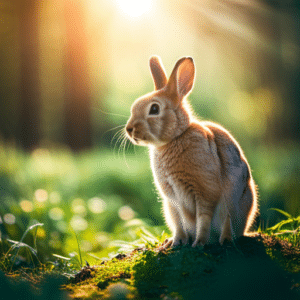Cute, fluffy, and often seen as the epitome of tranquility, rabbits are popular pets among animal lovers. But is the peaceful image of rabbits always accurate? Can these adorable creatures become aggressive and engage in fights with one another? Just like any other animal, rabbits have unique behaviors and instincts that can sometimes lead to confrontations. It’s essential to understand the reasons behind these behaviors to create a harmonious environment for your pet rabbits and prevent any potential conflicts. One question that often arises is, “Do rabbits fight?”
In this blog post, we will unravel the mysteries of rabbit behavior, explore common reasons for rabbit fights, and provide practical advice on how to prevent them and maintain harmony among your furry friends. By the end of this post, you’ll have a better understanding of rabbit behavior, including the circumstances in which rabbits fight, and be equipped with the knowledge to foster a peaceful coexistence for your pet rabbits.
Key Takeaways
Understanding rabbit behavior is essential for preventing conflicts and promoting harmony.
Common reasons for fighting include territorial disputes, dominance, and mating attempts.
Preventing fights among rabbits can be done by providing adequate space, neutering them at 4-6 months of age, and introducing new rabbits gradually in a neutral environment.
Introduction: Understanding Rabbit Behavior

Rabbits are complex, social creatures with unique behaviors and instincts. Comprehending why rabbits engage in combat is key in toe venting conflicts and promoting harmony among them. Some beneficial reasons for rabbits to engage in combat include participating in mating rituals, which can be a part of the bonding process. Ensuring their well-being requires recognizing signs of a severed bond between two rabbits, such as full-fledged fights or plucking fur.
Avert potential skirmishes by introducing rabbits to each other gradually and cautiously in a neutral space. Bonding rabbits in bonded pairs or groups can be advantageous for their welfare by:
Decreasing stress levels
Aiding with grooming
Furnishing amusement
Providing companionship as a bonded pair.
The most expedient method of adopting bonded rabbits is to obtain brothers and sisters from the same litter, which are baby rabbits. If your bunny’s companion passes away, it is advisable to introduce them to a new healthy rabbit friend in a suitable manner.
Why do Rabbits Fight?
Fights between pet rabbits can be categorized into two types: fights between strangers and fights between acquaintances. The potential causes of rabbit aggression and fighting include:
Defending territory and food sources
Asserting dominance
Protecting mates
Ensuring survival
Neutered male rabbits may show less aggression.
Observable indications of rabbit fighting include:
Biting
Chasing
Mounting
Pinned tail
Raised front paws resembling a boxer
Bared teeth
Thumping of back legs
Territorial behavior
Rabbits attain sexual maturity at around 4-6 months of age.
Common Reasons for Rabbit Fights

Conflicts among house rabbits may arise due to territorial disputes, attempts to establish dominance or mating attempts. If resources such as sustenance and hydration are in short supply, two rabbits could engage in a dispute over them. A genuine altercation among other rabbits is characterized by aggressive behaviors such as biting, chasing, and mounting, which are different from playful activities.
Given their highly social nature, their well-being can be significantly improved by maintaining rabbits in bonded pairs or groups. Awareness of these common reasons for rabbit fights is the first step towards prevention and ensuring a peaceful environment for your pet rabbits.
Territory Disputes Among Rabbits
Rabbits may engage in territorial disputes due to their territorial nature and the desire to protect their space and possessions. This aggression can be hormonally driven and is normal behavior for rabbits, leading to rabbits fighting. Physical indications of rabbits fighting include fur loss, scratches, and bite marks. The severity of the injuries may vary depending on the intensity of the altercation.
Preventing conflicts between rabbits can be achieved through securing sufficient space for each rabbit, neutering, and suitable introduction of new rabbits. If your rabbits fight, it is recommended to separate them immediately. If the fight is severe, veterinary care may be necessary. Reintroduction should be done carefully, adhering to the appropriate guidelines.
Dominance and the Fight for the Alpha Position

Dominance plays a significant role in rabbit fighting, being of importance for the establishment of a hierarchy. The potential outcome of keeping all females or all males together could be a dominant fight, leading to rabbit fighting. Understanding the role of dominance in rabbit conflicts can help us take appropriate measures to prevent such confrontations.
Harmony among pet rabbits can be fostered by providing an environment that allows them to establish a hierarchy without the need for aggressive encounters. Being aware of the dynamics between dominant and submissive rabbits can be crucial in creating a peaceful living situation for them.
Mating: A Common Cause for Fights
During mating season, increased aggression and rabbit fighting among rabbits is caused by the competition for mates and the need to establish dominance. Indications of mating among rabbits include:
Females displaying signs of being in heat
Pregnant females exhibiting aggressive behavior
Male rabbits grunting during mating
Males exhibiting increased seeking behavior for stimulation
Females exhibit symptoms when males are nearby
Female rabbits that are not neutered are more likely to fight with other female rabbits. They may also engage in combat with male rabbits. It is suggested that one should provide sufficient space for each rabbit, neuter them, and introduce new rabbits properly to reduce the chances of rabbit fighting during mating season.
A better understanding of the role of mating in rabbit conflicts allows for more effective management of the situation and the prevention of unnecessary fights.
Signs of Fighting in Rabbits

Biting, chasing, and mounting can be indicative of rabbit fighting. Moreover, a pinned tail, rised front paws resembling a boxer, bared teeth, thumping of back legs, and territorial behavior can be signs of rabbit aggression. Aggressive behaviors, such as:
tail up
ears back
growling
boxing
circling
chasing
biting
May be indicative of rabbit fighting among rabbits. If these behaviors are observed repeatedly, it may be an indication of fighting rather than rabbits play.
Differentiating between rabbits’ normal behavior and real rabbit fighting is possible. Normal behavior includes grooming, playing, and snuggling, whereas a real brawl involves aggressive behaviors such as tail up, ears back, growling, boxing, circling, chasing, and biting. If these behaviors occur repeatedly, it may suggest that the rabbits are fighting rather than playing. Identification of these signs enables appropriate actions to prevent further conflict and injury.
Physical Signs and Injuries
Rabbits may manifest physical indications of rabbit fighting such as fur loss, scratches, and bite marks. Additionally, they may exhibit aggressive behavior including lunging, chasing, and boxing. Recognizing these signs is vital, enabling you to take appropriate action in separating the rabbits and providing necessary care.
It is possible to detect injuries in rabbits by observing indications of pain, e.g. limping, unwillingness to move, or respiration difficulties. Further signs of injury can include swelling, bleeding, and secretions from the eyes, nose, or mouth, which may be caused by rabbit fighting. Being vigilant about these signs can help us provide timely care and prevent further harm to our pet rabbits.
Behavioral Changes: Indicators of Stress and Aggression
Indications of stress and aggression in rabbits, which may lead to rabbit fighting, may include:
Excessive nervousness and jumpiness
Restlessness
Unusually aggressive and difficult to handle
Lethargy
Lack of interest in food
Rapid breathing
Hiding during normal times of interaction
Sitting hunched in a ball
Charging and nipping
Biting
Hiding
Chewing cage bars
Over-grooming
Altered feeding or toileting habits
Over-drinking
Playing in an abnormal manner
Alert posture with upright ears
Unexplained aggressive behavior
Tensing in an aggressive stance
Recognition of these signs of stress and aggression enables us to take appropriate measures to address the underlying issues and foster a more peaceful environment for our rabbits. This can be achieved by providing ample space for each rabbit, neutering, and introducing new rabbits in a suitable manner, which are effective approaches to abate aggression and discourage rabbit fighting among rabbits.
How to Prevent Fights Among Rabbits

Several steps can be taken to prevent fights among rabbits and promote a harmonious living environment. Here are some measures to consider:
Provide sufficient space for each rabbit.
Neuter your rabbits to reduce aggression.
Introduce new rabbits in a proper manner, gradually and under supervision.
By implementing these measures, we can ensure a peaceful and stress-free environment for our pet rabbits.
A deep understanding of rabbits’ unique behaviors and instincts plays an integral role in preventing conflicts and fostering harmony among these furry companions. By being proactive and taking the necessary steps to ensure a peaceful coexistence, we can create a happy and healthy environment for our pet rabbits.
Ensuring Adequate Space for Each Rabbit
Ensuring adequate space for each rabbit is critical in avoiding territorial disputes and rabbit fights. The optimal space for a rabbit is a single, enclosed area with a minimum recommended size of 12 square feet. It is imperative to provide adequate room for the rabbits to engage in their natural behaviors and have space to exercise, which can help prevent rabbit fighting.
Promoting rabbits’ physical and mental well-being and reducing rabbit fights can be achieved by allowing them at least 5 hours out of their enclosure for free-roaming time, enabling them to explore and exercise. Providing enough space for each rabbit is a crucial factor in preventing conflicts and ensuring a peaceful environment for our pet rabbits.
Neutering: A Proven Method to Reduce Aggression
Neutering serves to reduce the hormones that can lead to aggression, thus aiding in the prevention of aggression and rabbit fighting among rabbits. It is generally recommended that rabbits be neutered at 4-6 months of age to reduce the chances of rabbit fighting.
Neutering rabbits is of great significance as it can assist in the reduction of aggression and rabbit fighting among rabbits, as well as avert health issues that may arise as a consequence of hormones.
To avoid aggression and rabbit fights, and for the purpose of health and behavioral preservation, it is vital to neuter both sexes of rabbits when bonding them. By neutering our pet rabbits, we can significantly reduce the likelihood of fights and create a more peaceful environment for them to live in.
Proper Introduction of New Rabbits
It is advised to introduce a new rabbit cautiously, gradually, and on neutral ground to prevent rabbit fighting. If there is no available space for neutral territory, it is suggested to utilize two runs adjacent to each other in which the rabbits are exchanged between. The bonding process may range from a few weeks to six months.
Most rabbits will remain contentedly devoted once bonded, and rabbit fighting is less likely to occur. By introducing one rabbit or new rabbits to an existing group in a careful and controlled manner, we can minimize the risk of conflict and promote a harmonious living environment for all our pet rabbits.
What to Do if Your Rabbits Fight?

Knowing the appropriate steps to take to ensure their safety and well-being is crucial if your rabbits engage in a conflict. Separating the rabbits immediately, seeking veterinary care if necessary, and reintroducing them carefully are all crucial actions to take if your rabbits fight.
By understanding the reasons behind rabbit aggression and taking the necessary precautions to prevent conflicts, we can create a safe and harmonious environment for our pet rabbits. However, if a fight does occur, knowing what to do can make all the difference in preventing further harm and fostering a peaceful coexistence for our furry companions.
Separation: The Immediate Step
Avoiding additional harm necessitates the separation of fighting rabbits. A dustpan would be suitable, as it is large enough to separate the two rabbits without posing a risk of injury. It is advisable to observe the rabbits for any indications of hostility and seek the assistance of a veterinarian if deemed necessary.
Taking immediate action to separate fighting rabbits can prevent further injury and allow you to address the underlying issues that may have led to the conflict. Prompt intervention is crucial in ensuring the safety and well-being of your pet rabbits.
Veterinary Care: When is it Necessary?

If any injuries are present, seeking veterinary care for rabbits that have been involved in a fight is crucial. It is essential to thoroughly inspect both rabbits for any injuries and seek veterinary advice for the appropriate treatment. If one of the rabbits is believed to be injured following a confrontation, it is advisable to take the injured rabbit to the veterinarian in order to ascertain the severity of the injury.
Ensuring timely veterinary care for injured rabbits can help prevent complications and promote a faster recovery. By being vigilant about recognizing signs of injury and seeking professional help when necessary, we can provide the best possible care for our pet rabbits.
Reintroduction: Do’s and Don’ts
A wire divider in a rabbit enclosure enables rabbits to communicate with one another without physical contact, thus decreasing the possibility of disputes. Allowing a day or two for rabbits to be separated before attempting to bond them again can help prevent further conflicts. Adhering to the guidelines for reintroducing rabbits after a conflict and fostering a tranquil atmosphere afterward is vital.
By carefully reintroducing rabbits after a fight and promoting a peaceful environment, we can help to reestablish their bond and ensure a harmonious living situation for our pet rabbits. Being patient and attentive during the reintroduction process can make all the difference in fostering a peaceful coexistence among our furry friends.
Conclusion: Promoting Harmony Among Rabbits

Promoting harmony among pet rabbits requires understanding the complexities of rabbit behavior and taking appropriate measures to prevent conflicts. By providing adequate space, ensuring proper introductions, and neutering our rabbits, we can significantly reduce the likelihood of rabbits fighting and create a more peaceful environment for them to live in.
We hope that this blog post has provided valuable insights into the fascinating world of rabbit behavior and offered practical advice on how to prevent conflicts and foster harmony among your pet rabbits. By being proactive and attentive to the needs of our furry companions, we can create a happy and healthy environment for them to thrive in.
Summary
In conclusion, understanding rabbit behavior and taking appropriate measures to prevent conflicts is crucial for promoting harmony among our pet rabbits. By providing adequate space, ensuring proper introductions, and neutering our rabbits, we can significantly reduce the likelihood of rabbits fighting and create a more peaceful environment for them to live in. By being proactive and attentive to the needs of our furry companions, we can create a happy and healthy environment for them to thrive in.
Frequently Asked Questions
How do you know if rabbits are fighting?
Rabbits fighting will often show aggressive behaviors such as growling, hissing, boxing, lunging, circling, chasing, and biting. They may even attack each other’s faces, bellies, or genitals in an effort to draw blood. If these behaviors are repeated multiple times without either rabbit backing down, it is likely that the rabbits are fighting and should be stopped immediately.
Is it common for rabbits to fight?
Fighting is not uncommon behavior among rabbits, and they can be quite fierce. It may be a sign of dominance, a mating behavior, or part of the bonding process. In bonded pairs, fights indicate a broken bond which could be due to something having gone wrong.
Should you let rabbits fight it out?
It is not recommended to allow rabbits to fight it out, as they are known to hold grudges.
What happens if you let rabbits fight?
Rabbits can become quite aggressive when they fight, using their sharp teeth and claws to attack each other and potentially drawing blood. They may also kick hard and aim at faces, bellies an,d genitals. It is important to separate the rabbits immediately if they are fighting, as it usually means their bond has broken.
How do I stop my rabbits from fighting?
Separate your rabbits if they start to fight and provide distraction or interruption when possible. During the bonding process, separate and reintroduce them as needed. If they persist in being aggressive, you may need to bond them a second time.



